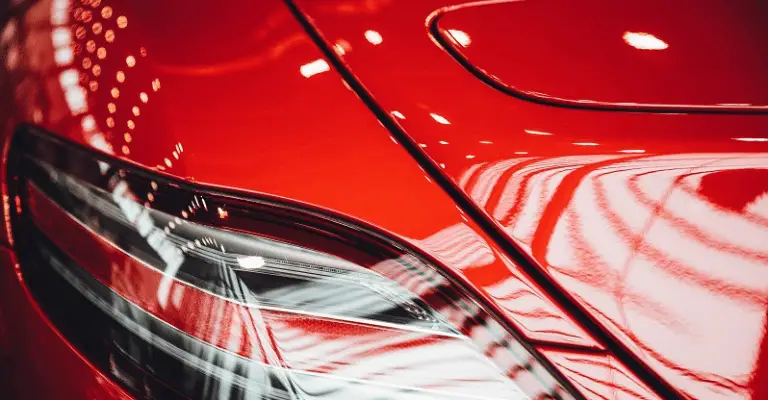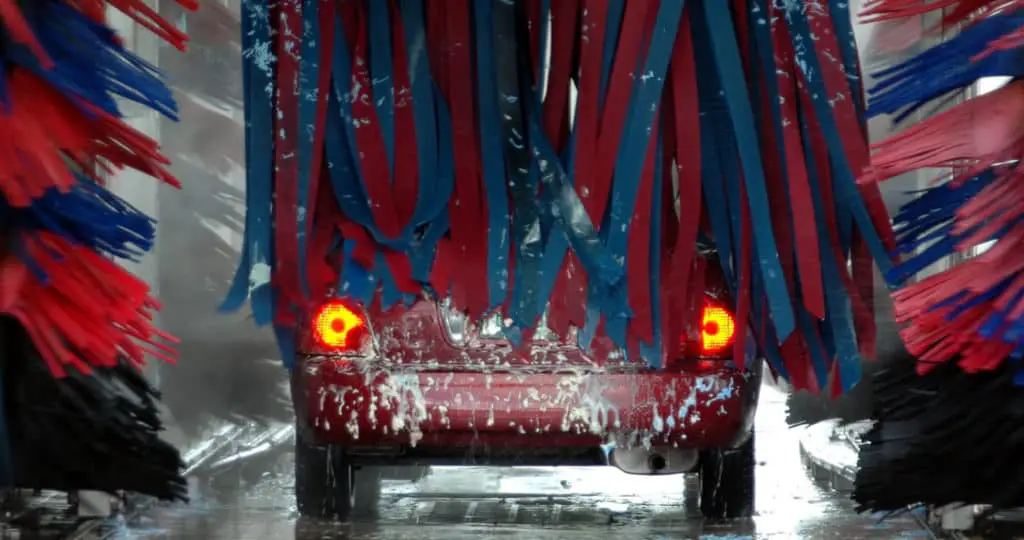- How to Clean Car Carpets Quickly (Without An Extractor) - July 10, 2024
- Can You Touch Up Clear Coat On A Car? Yes and No (Here’s Why) - November 25, 2023
- How To Wax A Car By Hand (For Beginners) - November 14, 2023
Last Updated on December 8, 2024 by Nate Schnell
Driving a brand-new car off the dealership lot is an unmatched thrill. The paint sparkles, the surface feels smooth as glass, and there’s that intoxicating new car smell. But as reality sets in, dust, grime, and the elements start working against your vehicle’s pristine look. That’s where waxing steps in—not as a superficial touch-up but as a critical step in preserving your car’s appearance and protecting its paint from environmental wear.
This guide delves into the details of waxing a new car: why it’s important, how to do it right, and how to choose the best products to keep your car looking showroom-fresh.
Do New Cars Come with Paint Protection?
It’s easy to assume that your new car comes fully protected straight from the manufacturer, but the reality isn’t so straightforward. While some manufacturers add a temporary protective layer of wax before shipping vehicles to dealerships, this isn’t universal. In many cases, it’s left to dealerships to apply wax or offer additional paint protection packages—for an extra fee.
Even if your car does arrive with a wax coating, this layer is typically temporary and will wear off quickly. Wax is an essential maintenance tool, but it’s not a substitute for regular cleaning and care. A clean car not only looks better but also prevents dirt and contaminants from causing damage to the paint over time.
What Happens If Your Car’s Paint Is Damaged?
Your car’s exterior is under constant attack from the elements. UV rays can fade the paint, harsh weather conditions like rain and snow can accelerate wear, and environmental pollutants like bird droppings or tree sap can cause permanent damage if not promptly removed.
A damaged paint job is more than an aesthetic issue. When the paint is compromised, the metal underneath becomes exposed to moisture, leading to rust and corrosion. Waxing helps protect against this by creating a barrier between the paint and the outside world.
Why Wax a Brand New Car?
Waxing is one of the simplest yet most effective ways to protect your vehicle. Here’s why it’s especially beneficial for a new car:
- Paint Protection: Wax shields your car’s paint from harmful UV rays, road grime, and environmental pollutants.
- Water Repellence: A waxed surface is hydrophobic, causing water to bead and roll off, taking dirt with it.
- Prevention of Water Spots: Hard water deposits can damage your paint. Waxing prevents these minerals from bonding with the surface.
- Simpler Cleaning: Wax makes it harder for dirt to stick, making your car easier to wash.
- Shield Against Minor Scratches: While not a substitute for a clear coat, wax provides a layer of defense against small abrasions.
- UV Protection: Wax reflects sunlight, reducing the risk of fading and damage from UV rays.
- Enhanced Appearance: Wax enhances the gloss and shine of your car, keeping it looking new longer.
Should You Wax a New Car?
The short answer is yes. With today’s modern paint-curing processes, you can wax your car immediately after bringing it home from the dealership. Factory paint jobs are fully cured by the time they arrive at the dealership, so there’s no need to wait before waxing. The sooner you wax, the sooner your car gets the protection it needs.
What Type of Wax Is Best for New Cars?
Choosing the right wax depends on your priorities, as each type offers distinct advantages.
- Ceramic Wax
- Pros: Extremely durable, resistant to heat and UV rays, and delivers exceptional hydrophobic properties.
- Cons: Higher cost and a slightly steeper learning curve for application.
- Synthetic Wax
- Pros: Long-lasting, easy to apply, and budget-friendly.
- Cons: May not achieve the same depth of shine as other options.
- Carnauba Wax
- Pros: Natural and eco-friendly, with a warm, rich shine that’s hard to match.
- Cons: Requires frequent reapplication and may be more expensive than synthetic options.
For new cars, synthetic wax is often the most practical choice due to its durability and ease of use. However, if you’re after a showroom-quality shine, carnauba wax is a great option.
How Long Should You Wait Before Waxing a New Car?
Thanks to modern paint technology, you don’t need to wait before waxing a new car. Unlike older painting methods that required a curing period, factory-cured paint is ready for waxing immediately. Waxing your car as soon as possible gives it an early layer of protection against environmental damage.
How Often Should You Wax a New Car?
The frequency of waxing depends on the type of wax you use, your driving habits, and the conditions your car is exposed to. As a general rule, waxing every three months is sufficient for most cars. If you’re using a high-quality synthetic or ceramic wax, you may be able to extend this interval to six months.
If you notice water no longer beads on the surface or if the paint starts to feel rough to the touch, it’s time to reapply.
How Long Does Wax Last?
The longevity of wax varies based on the product and environmental factors. Carnauba wax typically lasts a few weeks to a month, while synthetic waxes can provide protection for up to six months. Ceramic-based waxes are the most durable, often lasting up to a year with proper application.
Tips for Waxing a New Car
To get the best results, follow these key steps when waxing your new car:
- Start with a Clean Surface: Wash your car thoroughly to remove dirt, dust, and contaminants. Dry it completely before applying wax.
- Use the Right Tools: A soft foam applicator and microfiber cloths are essential for even application and streak-free buffing.
- Apply in Small Sections: Work on one panel at a time to ensure even coverage and avoid letting the wax dry out before buffing.
- Buff Gently: Use a clean microfiber cloth to remove excess wax, buffing in circular motions for a smooth, glossy finish.
- Avoid Direct Sunlight: Waxing in the shade or indoors prevents the product from drying too quickly and ensures a more uniform application.
Finishing Up
Waxing isn’t just about making your car look good—it’s an essential part of maintenance that protects your investment. Whether you choose ceramic, synthetic, or carnauba wax, the key is consistency. Regular waxing keeps your car’s paint protected from UV rays, dirt, and pollutants, preserving its glossy finish for years to come.
By taking the time to wax your new car, you’re not just enhancing its appearance—you’re extending the life of its paint, ensuring it looks as good as the day you drove it off the lot. With the right products and a little effort, your car can keep turning heads for years.



